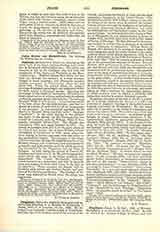

Jumièges, BENEDICTINE Abbey of, situated on the north bank of the Seine, between Duclair and Caudebec, in Normandy (Seine-Inférieure). The abbey was founded in 634 by St. Philibert, who had been the companion of Sts. Ouen and Wandrille at the Merovingian court. Philibert became first abbot, but was later on, through the jealousy of certain enemies, obliged to leave Jumièges, and afterwards founded another monastery at Noirmoàtier, where he died about 685. Under the second abbot, St. Achard, Jumièges flourished exceedingly and numbered within its walls nearly a thousand monks. Enjoying the patronage of the dukes of Normandy, the abbey became a great center of religion and learning, its schools producing amongst many other scholars, the national historian, William of Jumièges. It reached the zenith of its fame about the eleventh century, and was regarded as a model of perfection for all the monasteries of the province. It was renowned especially for its charity to the poor, being popularly called “Jumièges l’Aumônier”. In the ninth century it was pillaged and burnt to the ground by the Normans, but was rebuilt on a grander scale by William, Duke of Normandy, surnamed Longue-Epée. The church was enlarged in 1256, and again restored in 1573. The abbots of Jumièges took part in all the great affairs of the Church and nation; one of them, Robert, became Archbishop of Canterbury in 1040; many others became bishops in France, and some were also raised to the cardinalitial dignity. The fortunes of the abbey suffered somewhat through the English invasion of the fifteenth century, but it recovered and maintained its prosperity and high position until the whole province was devastated by the Huguenots and the Wars of Religion. In 1649, during the abbacy of Francis III, Jumièges was taken over by the Maurist Congregation, under which rule some of its former grandeur was resuscitated. The French Revolution, however, closed its career as a monastery, and only its majestic ruins now remain to show what it was in the days of its splendor. These comprise the church, with its beautiful twin towers and western facade, and portions of the cloisters and library. The contents of the latter were removed to Rouen when the abbey was supressed.
G. CYPRIAN ALSTON

